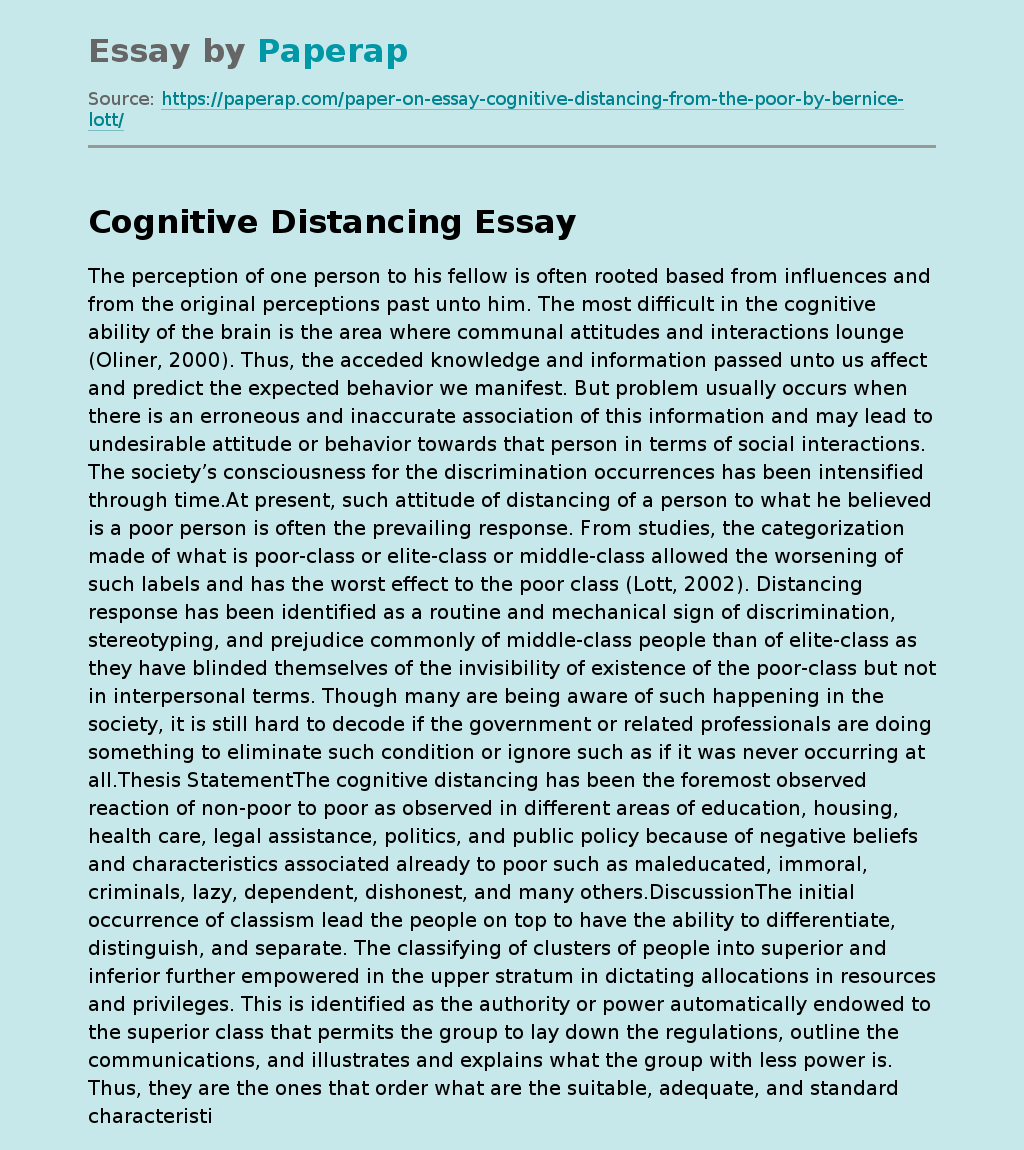Cognitive Distancing
The perception of one person to his fellow is often rooted based from influences and from the original perceptions past unto him. The most difficult in the cognitive ability of the brain is the area where communal attitudes and interactions lounge (Oliner, 2000). Thus, the acceded knowledge and information passed unto us affect and predict the expected behavior we manifest. But problem usually occurs when there is an erroneous and inaccurate association of this information and may lead to undesirable attitude or behavior towards that person in terms of social interactions.
The society’s consciousness for the discrimination occurrences has been intensified through time.At present, such attitude of distancing of a person to what he believed is a poor person is often the prevailing response. From studies, the categorization made of what is poor-class or elite-class or middle-class allowed the worsening of such labels and has the worst effect to the poor class (Lott, 2002). Distancing response has been identified as a routine and mechanical sign of discrimination, stereotyping, and prejudice commonly of middle-class people than of elite-class as they have blinded themselves of the invisibility of existence of the poor-class but not in interpersonal terms.
Though many are being aware of such happening in the society, it is still hard to decode if the government or related professionals are doing something to eliminate such condition or ignore such as if it was never occurring at all.Thesis StatementThe cognitive distancing has been the foremost observed reaction of non-poor to poor as observed in different areas of education, housing, health care, legal assistance, politics, and public policy because of negative beliefs and characteristics associated already to poor such as maleducated, immoral, criminals, lazy, dependent, dishonest, and many others.
DiscussionThe initial occurrence of classism lead the people on top to have the ability to differentiate, distinguish, and separate. The classifying of clusters of people into superior and inferior further empowered in the upper stratum in dictating allocations in resources and privileges. This is identified as the authority or power automatically endowed to the superior class that permits the group to lay down the regulations, outline the communications, and illustrates and explains what the group with less power is. Thus, they are the ones that order what are the suitable, adequate, and standard characteristics of the acceptable class, and dictate the characteristics of the less class as usually negative and undesirable.For some, moral exclusion is also one way of discriminating others leading to distancing because the poor is usually associated as less human or lacking of human essence as cited from Levens et al. 2000 (Lott, 2002). The discrimination with this concept made the action of the discriminating person justifiable, rational, and essential to protect one self of the contemplated harmful consequence of interacting with the poor. The problem of such judgment to poor made the persons not to feel consideration and understanding (Lott, 2002). Rather, they condemn them or tend to leave them alone and helpless. Through this, classism is further emphasized and executed in the society instead of lessening the occurrence of poverty.In the psychologist level, the existence of poor is often ignored as a critical part of research and theory (Lott, 2002). Also, middle-class tends to overlook and prefer to not pay attention of the poor class occurrence as if they do not exist to cover the poverty reality in the society.The poor are usually are criticized as people who do not know how to take care and grab opportunities endowed upon them because they are not diligent and do not have the capability to initiate. Thus, they are even known to have lack of interest when given the chance for education, health care, housing, or welfare because they are lazy and deficient in efforts to improve their lives even it is already infront of them. As Halpern 1993 concluded as cited by Lott 2002, the poverty issue is often perceived by the United States people as an individual’s dilemma because of his innate behavior that made him poor and not the socioeconomic status of the country that breeds poverty, disparity, and communal discrimination.The concept on poor is usually influences emanated from adults to children as proven in reviews and surveys of Chafel 1997 as cited by Lott 2002. The notion of non-poor adults to poor as less moral and their fate as due to personal failures are also the impression of the non-poor children to poor children. Compared to poor children, they view the non-poor as contempting the poor and that they view poor people as those in need of resources and assistance as shown in the study of Weinger 1998 as cited by Lott 2002.ConclusionThe distancing response is a prevailing reaction mostly observed among middle-class because of closer contact to them but ignorance of the existence of poor in the society but not on interpersonal interactions. The tendency to see poor as others because they are less in importance, disposition, and potential lead to voluntary or involuntary exclusion or discrimination of the poor when dealing and interacting with them. It must therefore be mandated that equal treatment must be conducted to make help and assistance to the poor be coupled with sympathy and compassion. This will make elimination of poverty sensitively and seriously.
Cognitive Distancing. (2019, Dec 05). Retrieved from https://paperap.com/paper-on-essay-cognitive-distancing-from-the-poor-by-bernice-lott/

